![]()
![]()
![]()
Use LEFT and RIGHT arrow keys to navigate between flashcards;
Use UP and DOWN arrow keys to flip the card;
H to show hint;
A reads text to speech;
49 Cards in this Set
- Front
- Back

|
Archaic Temple Foundation Early Roman ca. 7C BCE S. Omobono, Rome foundation of Temple of Fortuna |
|
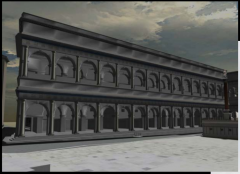
|
Basilica Aemilia Republican 2C BCE Roman Forum
digital reconstruction; collonades, some enclosed rooms; define edges of forum; basilica = large public building w/ civic uses (meetings, trials, religious) |
|
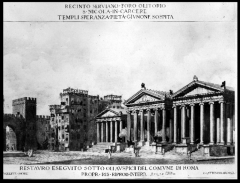
|
Forum Holitorium Temples Republican 3rd-2nd C BCE Spes, Janus, Juno Sospita
later becomes 12C church; regular colonnaded pattern on facade; victory temples |
|
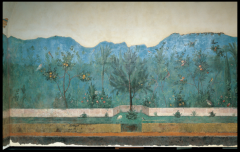
|
Garden Room Augustan 1st C BCE Villa of Livia, Prima Porta
best-preserved; fruit-bearing trees, lush landscape, abundance of animals = focus on fertility; sense of space with atmospheric perspective (low walls) |
|
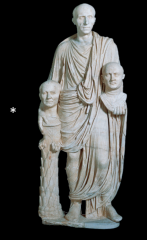
|
Patrician carrying two portrait heads Late Republican 1st C AD Marble
strong family resemblance; toga = man is honoring ancestors; head added later; republican portrait = realism |
|
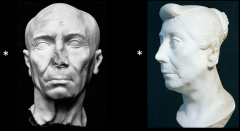
|
Republican portrait of a man/Head of an old woman Late Republican 30 BC/ 40-30 BC Marble
age is prestigious because high age minimum to run for office; realism; respect for civil leaders; nodus was typical hairstyle; fewer wrinkles on women |
|

|
Sanctuary of Fortuna Late Republican 2nd C BC tufa, concrete, limestone Praeneste
use of concrete allows huge structures to be built; immense size, colonnaded facade, many ramps and landings = impressive; small temple at top means grand approach |
|
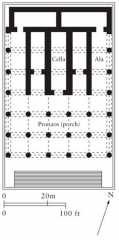
|
Temple of Jupiter Optimus Maximus Republican Late 6th C BC stone base, terracotta, wooden roof
3 cella, deep porch; the Jupiter cult was old |
|
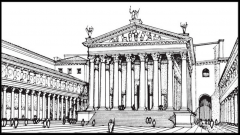
|
Temple of Mars Ultor Augustan reconstructed view Forum of Augustus
impressive facing; close in Forum of Augustus which mimics the Forum of Caesar
|
|

|
Temple of Mars Ultor Augustan 1st C BC Forum of Augustus, Rome marbles and concrete
many different types of marble show expansiveness of roman empire and wealth of Augustus |
|

|
Temple of Portunus Republican 2nd C BC Forum Boarium, Rome
emphasis on frontality (porch) reflects Etruscan influence; engaged columns reflects Greek influence; ionic capitals are Greek; tall/steep podium and stairs are Etruscan; blending of cultures |
|
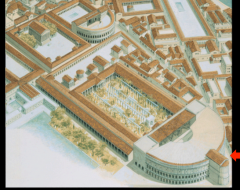
|
Theatre of Pompey Late Republican reconstruction Campus Martius, Rome
first permanent theatre; small temple (of venus) at back/top of seating; move away from fear of discussion; increase in Greek influence; also serves as public park |
|

|
Tomb relief of Publius Gessius family Late Republic 30-13 BC Marble near Viterbo
set up according to provision of the will members of the Gessius family; drapery = prestige; hands exposed; realism; ordinary expression |
|
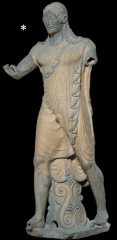
|
Apollo of Veii Etruscan 500 BC painted terracotta
dynamic, clothed, archaic smile; religious significance; compare to anavysos kouros |
|

|
Acquarossa plaque Etruscan 6th C BC Acquarossa painted terracotta
cartwheel, dancing, lyre, party, wine cup, nakedness, flute |
|

|
Acquarossa plaque Etruscan 6th C BC Acquarossa painted terracotta
symposium, feast, music, dogs |
|
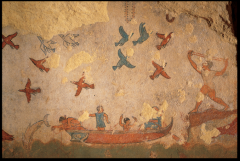
|
Detail of Tomb of Hunting and Fishing Etruscan Late 6th C BC Tarquinia wall painting
moving away from mythology, shows daily life |
|
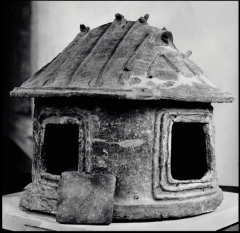
|
Hut Urns Early Etruscan 9th-8th C BC terracotta Tarquinia
life after death, possible structures of living houses as opposed to tombs, "going home" |
|

|
Etruscan Amphora Etruscan Late 7th C BC bucchero
diverges from Villanovan style, might imitate hardness or shininess of metal |
|
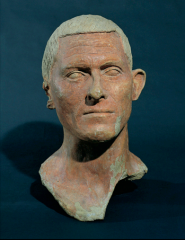
|
Portrait from Manganello Etruscan 1 C BC terracotta
individualized details (wrinkles, haircut, ears forward); moving away from ideals |
|
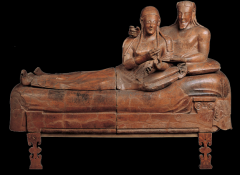
|
Sarcophagus Etruscan late 6th C BC Cerveteri terracotta
dining imagery, couch, man holds egg (rebirth, fertility); man and woman in symposium suggests better gender equality than Greeks; opportunity to study head figure |
|

|
Inscribed stone from Lapis Niger Roman 6th C BC
archaic Latin; site for cult or ritual, oration; shrine to Vulcan (Hephaestus); possibly where Romulus was buried |
|
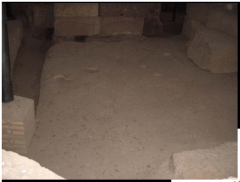
|
Palatine hut/ Hut of Romulus Roman 753 BC mud, local rock Palatine HIll
post holes suggest permanent huts or tents; locally revered as site of Romulus' palace |
|

|
bucchero fragment w/ "REX" inscription Roman 6th C BCE bucchero
shows that kings were a part of government |
|
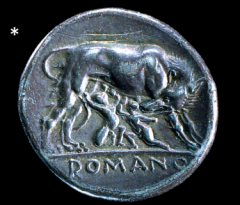
|
Roman Coin - Wolf Suckling Romulus and Remus Early Roman 275-260 BCE Silver
tells story of ancient Rome; shows pride in mythical heritage |
|
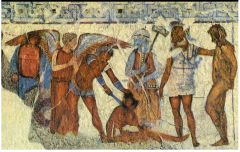
|
Sacrifice of the Trojan Captives Etruscan 350-300 BCE Francois Tomb, Vulci
Achilles sacrificing Trojans to mourn Patroclus; combines Greek and Etruscan myth; winged woman = Vanth; hammer man = Charun (blue like a corpse) |
|
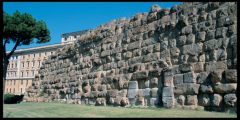
|
Servian Wall Republican 378 BC Around Capitoline, Quirinal, Viminal, Caelian, and Aventine Hills Rome
named after Servius Tulius after he reigned; built after the Sack of ROme in 390 BCE; advancement of defenses |
|
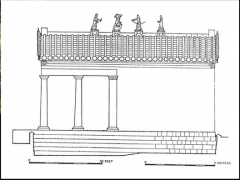
|
Temple of Veii reconstructed in elevation Etruscan 500 BC Veii; stone
frontal; porch w/ columns; high podium and steep steps; 3 cellas |
|
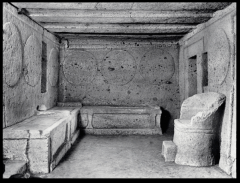
|
Tomb of Shields and Chairs Etruscan 7th C BC Cerveteri tufa
funerary couches resemble symposium couches; rooms branch off atrium; first chamber tombs |
|
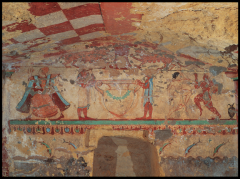
|
Tomb of the Lionesses Etruscan 520-510 BC wall painting Tarquinia
new checkerboard design; white/red = gender; wine pot, music, dancing, fertility tits on lionesses |
|
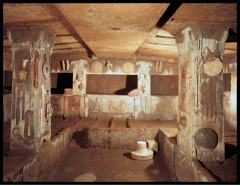
|
Tomb of the Reliefs Etruscan Early 3rd C BC Cerveteri stucco on tufa
elaborate; cubby holes no sofa; more everyday objects |
|
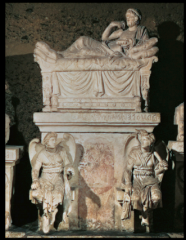
|
Urn of Arnth Velimnas Etruscan 150-100 BC limestone and stucco Tomb of the Volumnii, Perugia
Vanth = underworld; Etruscan divinities guard tomb door; specific features; inscription of name |
|
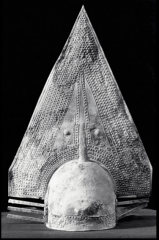
|
Early Etruscan Helmet Etruscan 8th C BC Bronze
elaborate; shows decoration and status as metalworking artisans |
|

|
Wounded Chimera Etruscan Early 4th C BC Bronze sculpture
emphasis on realize and dynamics speaks to Etruscan metalworking skill; mix of realism (muscles, veins) and style (mane); votive because "gift to the gods" inscribed on right foreleg |
|
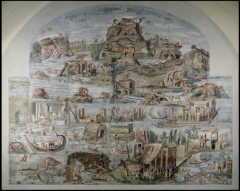
|
Nile Mosaic Late Republican 1st C BC Sanctuary of Fortuna, Praeneste
view of Egypt; fantastical creatures; atmospheric perspective (bending river) = depth; huge |
|
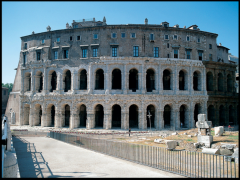
|
Theatre of Marcellus Late 1st C BC Rome Travertine
built by Augustus; arcaded supports preserved by converting upper levels into living spaces |
|
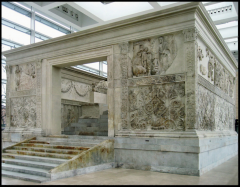
|
Ara Pacis Augustae Augustan 13-9 BC Campus Martius Carrara marble
"Altar of Augustan Peace"; burn food sacrifice; propaganda
|
|
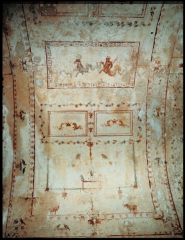
|
grotteschi Julio-Claudian 64-68 AD Golden House of Nero, Rome Ceiling painting
fine foliage; bird, animals, and marine creatures; inspired vatican art; volume/vista unemphasized; plain background with decorative devices |
|
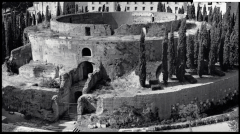
|
Mausoleum of Augustus Augustan 25 BC Tufa, concrete, travertine
propaganda statement for Julian family; echoes tumulus structure, call to Italic heritage; topped with gilded statue of Augustus; monumental scale; res gestae inscribed on front |
|
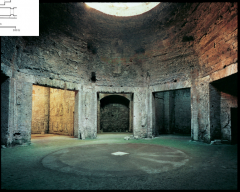
|
Octagonal Dining Room Julio-Claudian 64 AD Golden House of Nero Brick-faced concrete (+marble?)
covered concrete dome w/ oculus for light and air; innovative shape; usually used in baths-building; hid the light source from the viewer; possibly had a rotating gilded dome that dropped perfume and flowers |
|
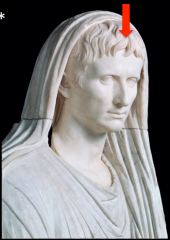
|
Portrait of Augustus as a Priest Augustan 1st C BC Via Labicana, Rome Marble
toga drawn over head = pontifex maximus; portrait and body carved seperately; hair part is characteristic; patera is a shallow offering dish |
|
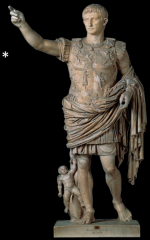
|
Prima Porta Augustus Augustan Early 1st C AD Carrara Marble
young, idealized; bare feet hero; cupid on dolphin call to Julian family ancestry (Venus); orator's stance; military general; triumphant cloak |
|
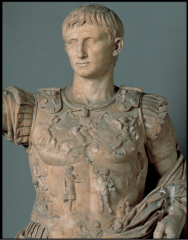
|
Prima Portia breastplate detail Augustan Early 1st C AD Carrara Marble
exchange of standards from Parthian barbarian to Roma, or soldier; sky god opening canopy; Mother Earth holding conucopia; Apollo and Diana mirrored by Sol and Luna; cosmic framework for Augustan reign; classicism |
|
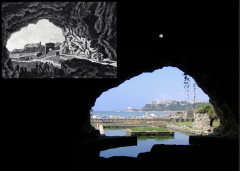
|
Grotto of Tiberius Julio-Claudian etching 1839; built in Republican period Sperlonga
emperor's wealth; had a dining platform and fish pond; kept statues in grotto; really cool |
|
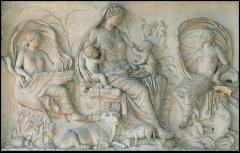
|
Tellus/Pax Relief Augustan 13-9 BC Ara Pacis, Campus Martius Marble relief panel
Mother Earth + 2 kids = fertility; or maybe Pax; personification of fresh water, air, and sea; docile livestock; |
|
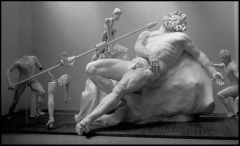
|
The Blinding of Polyphemus Julio-Claudian no date; reconstruction Sperlonga Marble?
hellenistic baroque; pathos (tortured, expressive, exaggerated bodies); shows Tiberius' private artistic tastes differed from his public ones (more classical) |
|
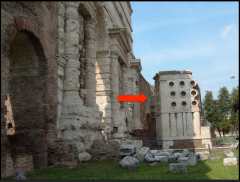
|
Tomb of Eurysaces Republican 30 BCE Porta Maggiore cement with travertine facing
ex-slave --> wealthy baker; could resemble grain measure or oven |
|
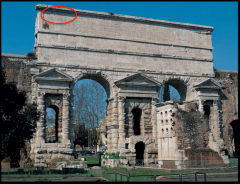
|
Porta Maggiore Julio-Claudian 50 AD part of Aqua Claudia travertine
monumental bridge over 2 roads; resembles triumphant arch; rusticated masonry to look stable; practical addition was monumentalized |
|
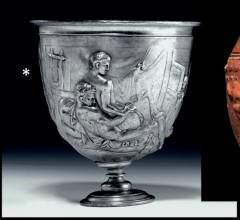
|
Warren Cup Augustan 30 BC/AD Silver
homosexual lovemaking; common and standard; voyeurism; lowering on support rope; open about nudity and sexuality |

